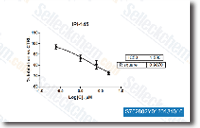The untapped diversity on the secondary metabolites of Laurencia, notably terpenes, has attracted consid erable consideration of various research groups around the world. The pharmacological potential of these compounds comprises the robust antibiotic, antiviral, antimalarial, antitrypanosomal, antileishmanial, anti inflammatory and anti carcinoma pursuits. A serious secondary metabolite selleck of L. dendroidea is the sesquiterpene elatol, a substance which has a high biocidal and anti epibiosis exercise and could be applied for that preparation of antifouling paints, or for your development of antimicrobials. A to start with try to the industrial application of elatol resulted from the filing on the patent in Brazil to make use of this compound as an antifouling agent. Even so, technological develop ments are nevertheless required to make certain its industrial viability.
This obstacle stems from your minimal yield of the extrac tion course of action, the complexity from the natural complete synthesis of elatol in laboratory, along with the failure within the significant scale cultivation of this species. selleckchem A doable alternate to circumvent this problem is definitely the synthesis of elatol from the laboratory employing genetically modified organisms. The cellular location plus the environmental elements that induce the production of this compound by L. dendroidea are acknowledged, but the genes concerned inside the biosyn thesis of this compound had been not nonetheless established, repre senting a fresh investigation frontier during the technological utilization of elatol. Recent scientific studies have determined a few of the genes responsible for your biosynthesis of terpenes in bacteria, fungi, and plants. The sequence homology observed amid no less than some classes of terpene synthases from these organisms might facilitate the look for homolog genes in L. dendroidea.
Regardless of the massive number of research based mostly on the chemical composition of Laurencia species, the gen etic expertise relating to this genus is presently limited to taxonomic markers. The genome dimension of L. dendroidea is estimated to get about 833 Mbp, based mostly on a review of a different species of your exact same genus, but gene sequences from this species haven’t previously been described. Within this deliver the results we analyze the transcriptomic  profile of L. dendroidea at numerous geographic locations, unveil the genes concerned within the biosynthesis of terpenoid compounds within this seaweed as well as discover the interactions concerning the alga as well as related microbiome. Solutions Specimens assortment Specimens of L. dendroidea were randomly collected inside the intertidal zone all through high tide at Azedinha found in Mangaratiba, each one of these places about the coast on the Rio de Janeiro state, Brazil.Seaweeds were co llected from virtually the exact same depth in two subsequent days, at about precisely the same hour, using the very same cli matic characteristics to lessen the variation in abiotic elements.
profile of L. dendroidea at numerous geographic locations, unveil the genes concerned within the biosynthesis of terpenoid compounds within this seaweed as well as discover the interactions concerning the alga as well as related microbiome. Solutions Specimens assortment Specimens of L. dendroidea were randomly collected inside the intertidal zone all through high tide at Azedinha found in Mangaratiba, each one of these places about the coast on the Rio de Janeiro state, Brazil.Seaweeds were co llected from virtually the exact same depth in two subsequent days, at about precisely the same hour, using the very same cli matic characteristics to lessen the variation in abiotic elements.
DNA Metabolism
In various diseases, such as type II diabetes, metabolic syndrome, and cancer, normal metabolism is disrupted.
